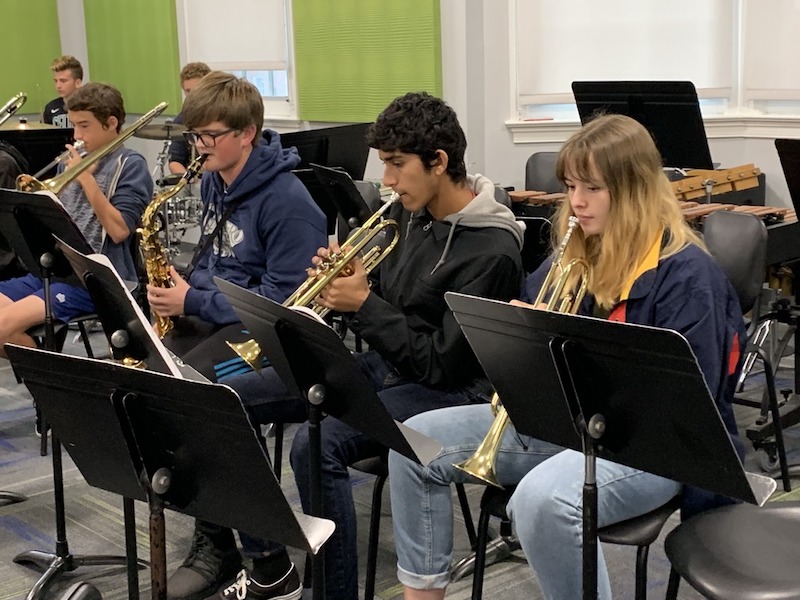Every year, choosing elective courses can be a struggle. Those who want to continue playing an instrument into Upper School can have a particularly hard time choosing whether to take jazz band or symphonic orchestra.
What exactly is the main difference between the two courses and how would you decide which elective to take?
According to sophomore tenor saxophone player Jasper Courtney, the difference lies in the erektionspiller two contrasting styles and type of music they play.
“I like jazz because you can improvise. It brings the creativity out in most people. Symphonic is more relaxing and is the class where one can play their favorite movie soundtracks or famous classical pieces,” Courtney said.
Joshua Frayer, the Conductor and Head of the Instrumental Department at WIS, echoed Courtney’s opinion.
“There’s not typically improvisation involved in symphonic orchestra,” Frayer said.
The choice between jazz band or symphonic orchestra is also very dependent on the instrument a student chooses to play. Specific styles of music match different types of instruments.
“[In symphonic orchestra], there is not typically a guitar, piano, and bass,” Frayer explained.
However, that isn’t to say that you should choose a course solely based on your instrument. Frayer agrees stating that he will try his best to make accommodations for instruments that do not usually fit in symphonic or jazz and that depending on the piece, the instrument could be incorporated.
A prime example of this is Jonathan Baunsgaurd who plays “Carol of the Bells,” a symphonic piece, with an electric guitar.

The two courses also vary in the different types of music they play. In symphonic orchestra, the pieces are usually derived from more classical music such as “Sabre Dance,” and movie/video game soundtracks such as “Baba Yetu” and “Guardians of the Galaxy.” Jazz has a different style including songs with some swing and rock covers such as “Seven Nation Army.”
For those who want a better example of the key differences and an idea of what the two bands play, the Winter Concert, open to all students, showcases a variety of different pieces.
This year, the Winter Concert will feature a much anticipated collaboration between the symphonic orchestra and vocal class in the form of “Baba Yetu.” According to symphonic orchestra flute player Emily Munzeur, Baba Yetu will be a highlight of the concert.
“We tried it with the vocal class two classes ago and it went pretty well,” Muenzer said.
However, this piece is not without its risks. Last year, an attempted collaboration with the vocal class and jazz band on the well known Aretha Franklin song “Respect” left a sour taste in many of the instrumental students.
“Jazz band was putting a lot more effort into it and their attitude surrounding it was a lot stronger than those in vocal,” symphonic orchestra student Rose Boehm said.
However, there was more to the collaboration failing then a weak attitude.
“I think we worked on [the Baba Yetu collaboration] it for a while, but it didn’t really live up [Mr Munt’s and my own] expectations,” Mr Frayer said. “Sometimes it works, and sometimes it doesn’t.”
So far, symphonic orchestra has worked hard to perfect the piece and vocal seems to be on the same page. The collaborative practices have gone well and the band recorded themselves playing “Baba Yetu” which allows vocal to practice the song without having to meet with the symphonic orchestra. Some symphonic students are still remain skeptical and don’t want a repeat of last year.
“I think we should give [the Baba Yetu collaboration] a chance, but if it proves to be the same as last year or it just doesn’t sound as good as we know it could, I don’t think [the Baba Yetu collaboration] is a good idea,” Boehm said.
Muenzer seems to disagree. There are some major differences this year compared to last year that will work in the collaborations favor. “Baba Yetu” works well as a collaborative piece as there are longer periods where the instruments play chords, allowing for a perfect opportunity for vocal to add a chorus. This creates a balance between vocal and symphonic so both are able to be heard.
“I think we need to wipe the slate clean and just start from a new beginning because it’s new students, it’s a new song, and I think that we can definitely make it into something good,” Muenzer said.
The result of the collaboration is still to be determined. However, the Winter Concert remains to be an opportunity to help students get a better grasp on the different type of music the bands play.
Ultimately, it is up to the student to choose which course to take.
It is essential to remember that there is time to experiment with each course and that taking both courses is a very viable option. The Upper School gives students the option to take both courses and eventually gives them the opportunity to decide which course they want to continue or if they want to pursue both styles.
“What appeals to you more?” Boehm asked. “[You should] play the music you want.”
































































